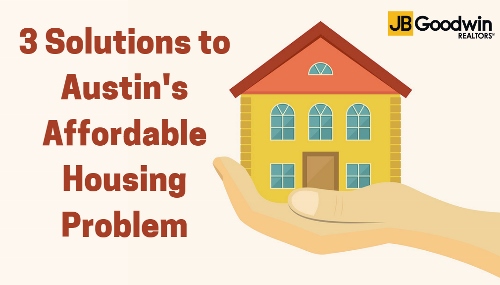 Austin's economy is booming, resulting in a rise in both the city's population and home prices. While the number of jobs continues to grow, wages have plateaued, meaning some of Austin's lower income earners have become priced out of owning a home. Renting is often not a solution, as rental prices have also increased.
Austin's economy is booming, resulting in a rise in both the city's population and home prices. While the number of jobs continues to grow, wages have plateaued, meaning some of Austin's lower income earners have become priced out of owning a home. Renting is often not a solution, as rental prices have also increased.
Here are some fast facts about Austin's growth between 2011 and 2015 (via the U.S. Census Bureau):
- Austin saw 3.1 percent growth annually to its population—nearly 4 times the national average of population growth
- 58 percent of new Austinites moved from within the country
- 189,000 new jobs were created vs. 93,085 new housing construction permits granted
East Austin Has Seen the Largest Rise in Prices
East Austin is a huge draw for new residents to Austin—especially millennials who are seeking affordable, easily walkable living close to downtown and all of life's daily amenity needs. This has led to the construction of newer, denser condo developments in East Austin, which has led to an increase in home prices in the area.
Here are some facts about East Austin's housing market between 2011 and 2015:
- 4 out of 6 East Austin ZIP codes more than doubled in housing prices over the 5 year period, compared to a 41.5% increase in Austin as a whole
- Each East Austin ZIP code's home prices grew between 56 and 162 percent over the 5 year period
- The average East Austin home spent 60 less days on the market in 2015 than it did in 2011
Three Solutions to the Austin Affordable Housing Issue
East Austin has seen the highest percentage increase in residential housing cost, forcing many of its lower-income residents out of the area. This has created a need for affordable housing in Austin, and in East Austin in particular. Let's take a look at three ways the city of Austin is combatting its affordable housing issue, through both public and private initiatives.
1. Subsidized Affordable Housing Programs
A number of affordable homes programs have sprouted up in East Austin. To qualify for most affordable housing units, families must earn less than 80 percent of Austin's Median Family Income (MFI), which would be about $62,250 for a family of four, or $43,600 for one person.
Most recently, the Mueller Affordable Homes Program has taken shape at the location of the former Robert Mueller Municipal Airport. This 700-acre development will be home to 13,000 people, and will include over 1,400 environmentally conscious homes and apartments made available as affordable housing. These homes will be scattered between full-market-value homes in the development, offering comfort and security in knowing that the affordable homes won't be easily singled out. Click here to learn more about the community of Mueller.
Other affordable homes programs in East Austin include the Reserve at Springdale in East Austin, and Easton Park. The Reserve at Springdale in East Austin, developed by Ryan Companies US Inc. in partnership with the Austin Affordable Housing Corp., will open in late 2016, offering 292 brand new apartment rental units. Easton Park, developed by Brookfield Residential, will offer 650 homes for low-income families, as well as 350 rental units.
2. Manufactured Houses Re-Zoning
Manufactured houses, including mobile homes and tiny homes, are a highly affordable option for low-income earners. Tiny homes have increased hugely in popularity across the country, as they offer a low-maintenance and no-frills alternative to renting or homeowning. At present, there are only 50 manufactured housing communities in Austin, allowing a maximum potential of 7,500 mobile homes. There are strict zoning laws in place that prohibit mobile home communities across most of the city. Most mobile home developments are outside the city, making it inconvenient for those who need to commute downtown for work.
Loosening the zoning prohibitions would result in a large increase in the supply of manufactured houses. In December 2015, Roberts Communities, one of Austin's prominent mobile home community developers, was granted a rezoning in Southeast Austin that could indicate a brighter future for mobile home communities within city limits. Roberts Communities is now planning a 100 tiny home development.
3. Accessory Dwelling Units
Accessory dwelling units are additional living quarters on single-family lots. This is a small guest house of sorts that sits on the same property as the main single-family home. The city of Austin recently relaxed the regulations for building these accessory apartments, so there are now 58,000 lots in Austin that are eligible for a second unit. According to the Real Estate Center of Texas A&M University, these units offer three unique possibilities for homeowners:
- These units can generate additional income, making it more affordable to remain within the neighborhood.
- These units can be used as an affordable option to house another family member within the same neighborhood, such as an older parent or child.
- They can allow homeowners to downsize without having to move out of their neighborhood. Homeowners can live in the smaller accessory unit while renting out their primary residence.
For advice on finding a home in the Austin area, contact JB Goodwin REALTORS® today! No matter what your budget, we'll find you the home that's right for you.
Source:
Leave A Comment